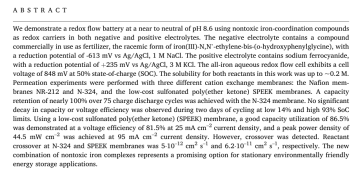Iron salt battery is interesting for sure. One aspect that I like is that I can take raw iron, plus 30% Muriatic acid (HCl), "shake and blend", vent off the H2 gas and I am left with FeCl in aqueous solution and both are plentiful, easy to get and not too expensive. So an all Iron battery from that perspective is great. This ironically is simpler than locating pure FeCl powder... EU... LOL
I downloaded a few documents, study's and solutions, I think its wise for me to read and get more acquainted, but near neutral pH is attractive.
Crossover or self-discharge is one of the larger aspects that I look at, and "coming from" the NiFe battery with its roughly 3& per month, that is my reference atm. Energy density and roundtrip efficiency are important too but so are system losses.
For flow battery's, we are dealing with two main aspects: The losses in the chemistry (primary) and losses in the system (secondary). The later obviously is the pumps, which is its own topic. So the less losses via crossover there is, obviously the greater the system efficiency and stability. One aspect which would make losses less severe is the fact that with a large enough PV system, input is always greater than losses and consumption, so there is that aspect to consider.
An all iron salt battery have theoretically an endless cyclability since we are only dealing with Fe(II)Cl and Fe(III)Cl speciesism, so the anolyte and catholyte are the same electrolyte, but we could be dealing with a higher self-discharge compared to the Mn/Fe cell (for the time being) which in turn have very low, but instead, potentially, have a lower cycle life due to chelate consuming the Fe and producing FeOx (I think it was) and in so doing, producing pure iron fallout and the cell potential goes down... is that sort of the boundary's we are talking about ??????
I am certainly not jumping the gun or claiming profound problems, just trying to learn and add to the discussion

- I am not set on needing infinite cycle life, finite if very long, can be fully acceptable. I can certainly look at and work with both types. They might both end up benefitting from that. There are so many aspects to both and flow battery in general beyond just the chemistry - take the ZnBr battery, I highlighted issues earlier in this thread which surpasses the higher energy density and that battery also have theoretical infinite cycle life.
(Saw a video last night about the road towards the All Iron Battery where the iron fallout was mentioned)



